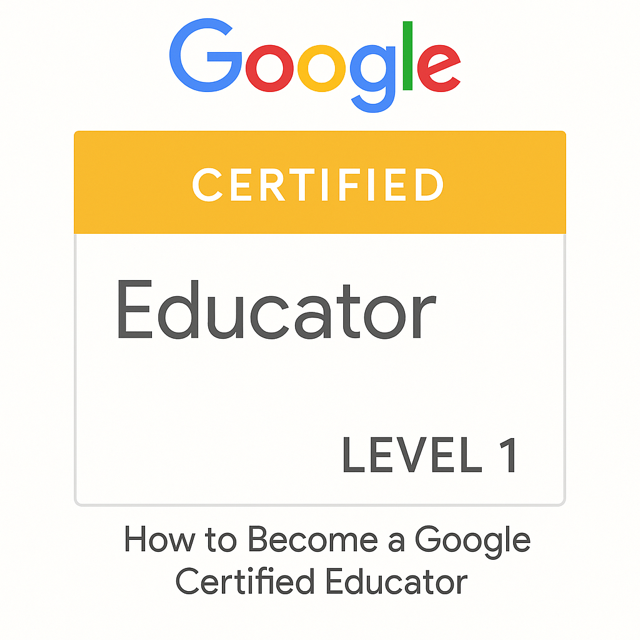In classroom’s all over the country, technology is transforming education, and teachers are increasingly turning to tools like Google Workspace for Education to enhance their classrooms. Becoming a Google Certified Educator is a powerful way for educators to demonstrate their proficiency in using these tools to improve teaching and learning. This certification not only boosts your skills but also enhances your resume, opens professional opportunities, and connects you to a global community of innovative educators. In this blog, we’ll explore what it means to become a Google Certified Educator, the steps to achieve Levels 1 and 2 certifications, their benefits, and tips for success, all while providing a detailed roadmap for educators eager to embark on this journey.
What is a Google Certified Educator?
The Google Certified Educator program, offered by Google for Education, is designed to validate teachers’ abilities to integrate Google tools into their teaching practices. The certification comes in two primary levels:
- Level 1: Focuses on the fundamentals of using Google Workspace for Education tools, such as Google Classroom, Drive, Docs, Sheets, Slides, Forms, and more, to enhance teaching and learning.
- Level 2: Builds on Level 1, diving deeper into advanced applications and innovative strategies for using these tools to transform educational practices.
Beyond these, Google offers advanced certifications like Google Certified Trainer, Coach, and Innovator, but Levels 1 and 2 are the starting points for most educators. These certifications are globally recognized, providing a badge you can display on your resume, portfolio, or website, signaling your expertise in educational technology.
Why Pursue Google Certified Educator Status?
Becoming a Google Certified Educator offers numerous benefits, both for personal growth and professional advancement. Here are some compelling reasons to pursue this certification:
- Enhance Classroom Efficiency: Google tools streamline tasks like creating assignments, grading, and communicating with students and parents. Certification equips you with the skills to use these tools effectively, saving time and boosting productivity. For example, Google Classroom allows teachers to organize assignments and provide real-time feedback, while Google Forms can create quick quizzes to assess student understanding.
- Engage Students with Technology: Students today are digital natives, and certified educators can leverage tools like Google Slides for interactive presentations or Google Earth for immersive geography lessons, making learning more engaging and relevant.
- Professional Development and Credibility: Earning a Google Certified Educator badge demonstrates your commitment to professional growth and establishes you as a tech-savvy educator. This credential can enhance your resume and make you stand out in job applications or promotions.
- Join a Global Community: Certification connects you to a network of Google Certified Educators, providing access to resources, ideas, and collaboration opportunities through Google’s Educator Groups and Champions community.
- Career Advancement: Schools and districts increasingly value educators who can lead technology integration. Certification can open doors to roles like instructional coach or technology coordinator. Some educators even pursue additional income streams as freelance Google Certified Trainers.
- Stay Current with EdTech Trends: The certification process keeps you updated on the latest Google tools and best practices, ensuring your teaching remains innovative and effective in a rapidly evolving digital landscape.
- Support Digital Citizenship: The program teaches you how to guide students in using technology responsibly, fostering skills like safe internet practices and digital literacy, which are critical in today’s world.
Steps to Become a Google Certified Educator
Achieving Google Certified Educator status involves preparation, training, and passing an exam. Below is a step-by-step guide to earning Level 1 and Level 2 certifications. Google for teachers is so very helpful.
Step 1: Understand the Certification Requirements
- Level 1: Designed for educators new to Google Workspace, this certification focuses on basic proficiency in tools like Google Classroom, Drive, Docs, Sheets, Slides, Forms, Calendar, Gmail, Meet, and YouTube. You’ll need to demonstrate how to use these tools to support curriculum goals and enhance student learning.
- Level 2: Aimed at educators with some experience, this certification requires a deeper understanding of Google tools, including advanced features like Google Scholar for research, Google Sites for creating websites, and innovative teaching strategies like flipped classrooms. You must have a solid grasp of Level 1 skills before attempting Level 2.
Both certifications require passing a 180-minute online exam, which includes multiple-choice questions and performance-based tasks to test your practical skills. The Level 1 exam costs $10, and the Level 2 exam costs $25, with certifications valid for three years.
Before diving into exam preparation, familiarize yourself with Google Workspace for Education tools. Here’s a quick overview of key applications covered in the exams:
- Google Classroom: Create and manage digital classrooms, assign work, and provide feedback.
- Google Drive: Organize and share files, collaborate in real-time, and manage permissions.
- Google Docs, Sheets, and Slides: Create collaborative documents, spreadsheets, and presentations.
- Google Forms: Design quizzes, surveys, and forms for assessments and data collection.
- Google Meet: Facilitate virtual classes and meetings.
- Google Sites: Build websites for class projects or portfolios.
- Google Calendar, Gmail, and Groups: Streamline scheduling, communication, and collaboration.
You can explore these tools through Google’s free Fundamentals Training (for Level 1) and Advanced Training (for Level 2) on the Google for Education Teacher Center.
Step 3: Enroll in Training Programs
While self-study is an option, structured training can significantly boost your chances of passing the exam. Here are some popular training options:
- Google for Education Teacher Center: Offers free, self-paced courses covering all exam topics. The Fundamentals Training includes 13 units for Level 1, and the Advanced Training prepares you for Level 2. These courses include videos, tutorials, and practice activities.
- Online Courses: Platforms like Udemy, Canopy Education, and Deploy Learning offer instructor-led or self-paced courses tailored to the certification exams. For example, Udemy’s “Complete Google Certified Educator Level 1 and 2 Masterclass” includes video tutorials and comprehension checks.
- Bootcamps and Workshops: Organizations like the Learning Technology Center (LTC) and Canopy Education provide intensive bootcamps, ranging from one-day sessions to multi-week programs, often with exam vouchers included. These are ideal for educators seeking hands-on guidance.
- School or District Programs: Some schools partner with Google for Education Partners to offer in-district training. Check with your administration for local opportunities.
Step 4: Practice and Prepare for the Exam
The certification exams are rigorous, combining multiple-choice questions with performance tasks (e.g., creating a Google Form or setting up a Google Calendar event). Here’s how to prepare:
- Complete Practice Activities: Use the Google Teacher Center’s practice quizzes and activities to test your knowledge. For example, practice creating a Google Sheet with formulas or designing a Google Site.
- Take Practice Exams: Some platforms, like Deploy Learning, offer practice exams that mimic the real test format. These help you get comfortable with the exam’s structure and time constraints.
- Review Weak Areas: If you struggle with tools like Google Sheets (a common challenge), watch YouTube tutorials or practice specific tasks, such as creating charts or using formulas.
- Join Study Groups: Collaborate with colleagues or join online communities like the Google Educators Group (GEG) to share tips and resources. Studying with peers can make preparation more engaging.
Step 5: Register and Take the Exam
To take the exam:
- Register: Visit the Google for Education Teacher Center, select the desired exam (Level 1 or Level 2), and pay the fee ($10 for Level 1, $25 for Level 2). You’ll receive a unique exam link within 24 hours.
- Prepare Your Setup: Ensure you have a computer with a webcam (for proctoring), a stable internet connection, and the latest version of Google Chrome. The exam allows you to access Google apps as references, so no need to memorize everything.
- Take the Exam: You have 180 minutes to complete the exam, which requires an 80% score to pass. The test includes both theoretical questions and hands-on tasks, such as setting up a Google Classroom or creating a Google Form. Results are typically sent via email, along with a digital badge and certificate if you pass.
If you don’t pass, you can retake the exam after a waiting period (3 days for the first retry, 7 days for the second).
Step 6: Leverage Your Certification
Once certified, maximize the benefits:
- Display Your Badge: Add the Google Certified Educator badge to your resume, LinkedIn profile, or email signature to showcase your expertise.
- Join the Google for Education Champions Community: Engage with other certified educators to share ideas and resources. This community is especially valuable for those pursuing advanced certifications like Trainer or Innovator.
- Pursue Advanced Certifications: After Level 2, consider becoming a Google Certified Trainer, Coach, or Innovator to further your impact and career. These require additional steps, such as submitting a video or leading training sessions.
Tips for Success
- Start with Level 1: Even if you’re tech-savvy, begin with Level 1 to build a strong foundation. It’s designed for beginners and ensures you’re comfortable with core tools.
- Schedule Study Time: Dedicate consistent time to training, especially if you’re balancing teaching responsibilities. Aim for 8–10 hours of preparation for Level 1 and 10–15 hours for Level 2.
- Practice Hands-On: The exam’s performance tasks require practical skills, so create sample assignments in Google Classroom or experiment with Google Forms to build confidence.
- Use Free Resources: Take advantage of Google’s free training materials and YouTube tutorials to supplement paid courses.
- Stay Calm During the Exam: The three-hour duration can be intense, so take breaks if needed and read questions carefully. Since it’s an open-resource exam, use Google apps to double-check your work.
Challenges and How to Overcome Them
- Time Management: The exam’s length can be daunting. Practice with timed tasks to improve efficiency.
- Technical Issues: Ensure your internet and Chrome browser are up to date to avoid glitches. Have a backup device ready if possible.
- Unfamiliar Tools: If you’re less comfortable with tools like Google Sheets, spend extra time practicing their features, such as formulas or data visualization.
Conclusion
Becoming a Google Certified Educator is a rewarding journey that equips you with the skills to transform your classroom and advance your career. By mastering Google Workspace tools, you can create engaging, efficient, and innovative learning experiences for your students while establishing yourself as a leader in educational technology. Whether you’re a new teacher or a seasoned educator, the Level 1 and Level 2 certifications offer achievable milestones to enhance your teaching practice. Start with the Google Teacher Center’s free resources, practice diligently, and take the exam with confidence. Once certified, you’ll join a vibrant community of educators driving the future of education. Ready to get started? Visit the Google for Education Teacher Center and take the first step toward becoming a Google Certified Educator today

